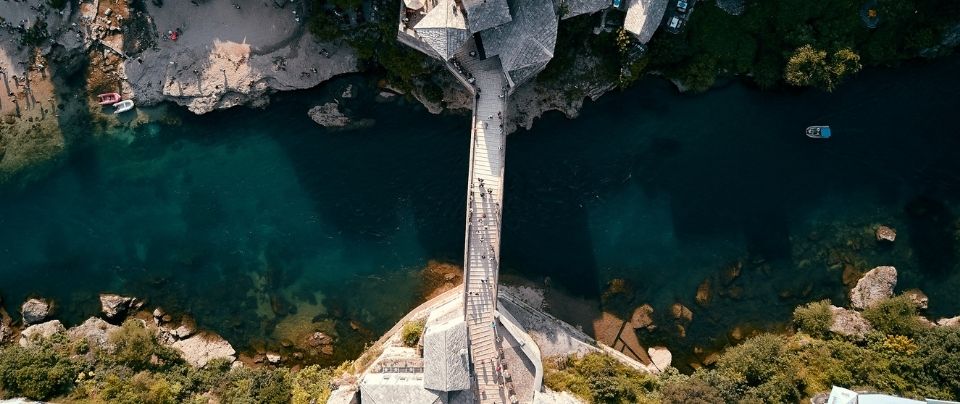

A city of stone on stone, historical, political, scientific and cultural center of Herzegovina lies at the foot of the slopes of Velez Mountain, in the Neretva River valley. It is a city of sun, greenery and flowers, with a mild Mediterranean climate, even fragrances from the sea reaching it.
Mostar is the city of contrasts, wide roads, narrow streets, the traditional Kujundziluk (old bazaar) and a contemporary center, a city in which the culture and art of the east and west meet, which have left visible traces that have with stood the test of natural forces and rulers. Next to modernly built edifices there rise the towers of churches and the minarets of mosques. Nonetheless, the most magnificent stone monument is the Stari Most (Old Bridge), built in 1566 according to the plans of Hayruddin, the great Turkish builder of the 16th c. it has a large stone arch and has been entered on UNESCO's World Heritage List.
City Sightseeing in Mostar
The Old Bridge (Stari Most 1566;2004)
An almost instinctive image comes to mind when one thinks of Mostar and that is that of its splendid Old Bridge; it thereby follows that this stone masterpiece is the monument that gave its name to the city and that it symbolizes its many features.
It was built during the Ottoman period by the Turkish architect Hajrudin and commissioned by the sultan Soliman the Magnificent; it was completed in 1566 after nine years’ work. Right from the start, the bridge became part of various local legends, one of which narrates the stubbornness of Hajrudin who stopped underneath it for three days and three nights in order to demonstrate its absolute solidity.
The Stari Most joins the two banks of the Neretva River together and is situated between the Herceguša and Tara Towers, on the left bank, and the Halebija on the right: it is 28.7 metre long, 4.49 metre wide and is characterized by a single stone arch which, in summer, stands 21 metres above the water.
In July 2005, the Old Bridge and the entire old city became officially a part of the Cultural Heritage of the UNESCO.
Bišćevića corner (1635)
Turkish house or Bišćevića corner, is one of the most beautiful preserved residential structures from the Turkish period. It was built in 1635. This 17th century Ottoman house rests (some parts on pillars over 5m long) on the eastern banks of the Neretva. There is a conversation or gathering room or divanhan preserved in authentic Ottoman style. Throughout the house one can see original household items whilst the courtyard is a fine example of the Ottoman style.
Hamam (Turkish bath)
It is covered with 6 domes and an extended ceiling built of stone; situated n the vicinity of the Old Bridge it was most probably built in the second part of the 16th century.
In Hamam there is the permanent exhibition „Mostar History“ and the 10 minutes movie „Mostar before, during and after the war“.
Crooked Bridge (Kriva Ćuprija) (1558)
On the Radobolja River, near to where it joins the Neretva, close to the Old Bridge, stands the Crooked Bridge, a miniature version of the Stari Most. Built in 1558, eight years prior to the more famous Old Bridge, it is believed to have been built as a trial attempt for the following, more daring, construction.
Destroyed in 2001 by the river flooding, it has recently been rebuilt.
Karadjoz-Bey Mosque, Koski Mehmed pasha Mosque, Tabacica
Mostar is a city rich in mosques, to be found in each and every district, which well represent the typical Ottoman style. Small but elegant, both from an architectural and a cultural point of view in a wider sense, these are buildings that are well worth visiting not only for the beauty of their interiors but also for tangible evidence of the life and culture of the Ottoman period in Bosnia Herzegovina.
Tara and Halebija Towers (17th century)
The two towers, standing on opposite sides of the Old Bridge, soar as architectural buttresses of the bridge itself, and seem to be stone guardians controlling the way. On the east bank there rises the semi-circular Tara Tower, a deposit for ammunitions in the Ottoman era and, today, seat of the Museum of the Old Bridge.
The Halebija, on the west side, was once the prison on its lower floors, and small barracks on its upper floors, also used as a look-out post. Behind the Tara, on the left bank of the Neretva River, there is the Herceguša Tower, built in the first half of the 15th century during the reign of Herceg Stjepan Vukčić Kosača.
Lufthansa City Center